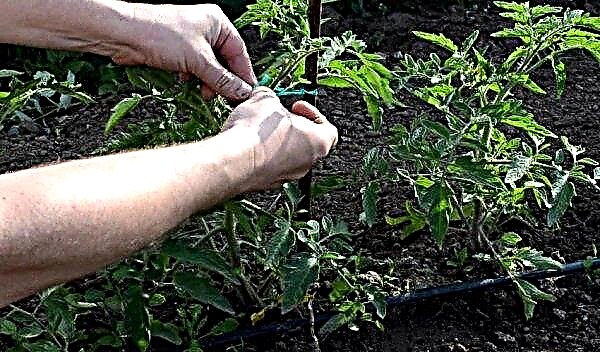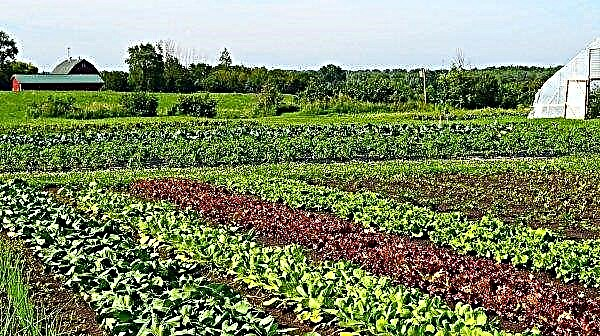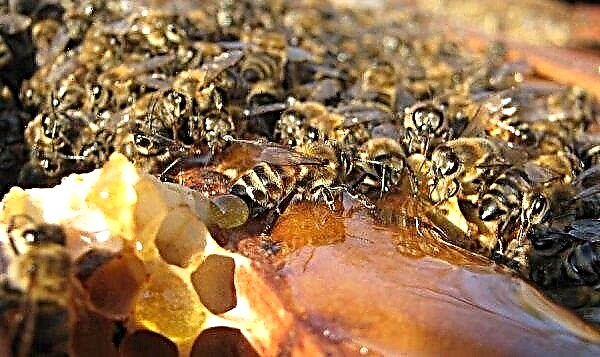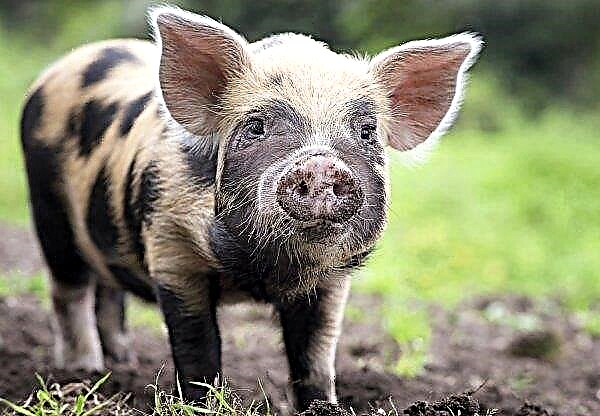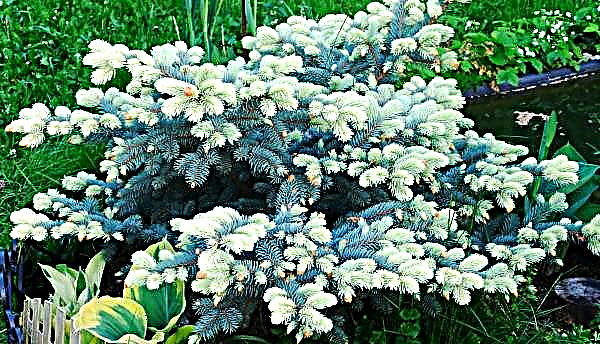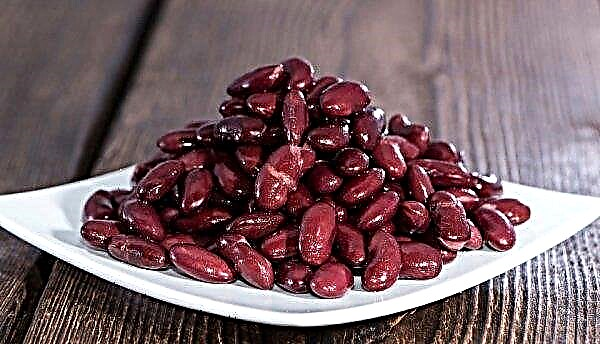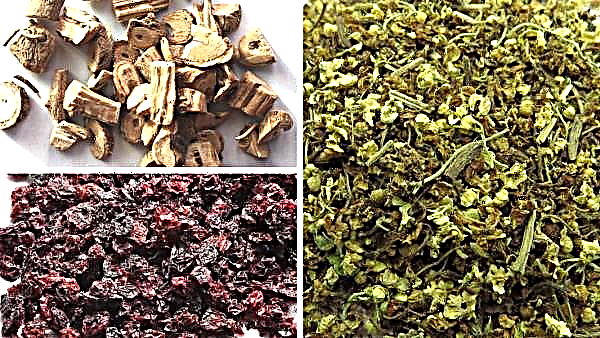Choosing seeds for planting late cabbage, you can get lost in a wide variety of products. One of the attractive varieties - late-ripening cabbage Lennox - will be discussed in our today's material.
Variety breeding history
The creator of the Lennox cabbage variety is the Dutch company BEJO ZADEN B.V. This is a late-ripening crop grown both on private farms and on an industrial scale.
Description and characteristic
To know what this culture is, we suggest that you familiarize yourself with its description.
Features of head of cabbage
For a fork of this cabbage such features are characteristic:
- weight ranges from 3-5 kg;
- has an oval-oblong shape;
- the leaves are slightly concave, slightly wrinkled, thin;
- head of cabbage has a good density;
- grayish-green foliage, densely covered with a coating of wax;
- the cabbage is sweetish in taste, not bitter;
- the stump is small compared to other varieties;
- has a long shelf life (up to 8 months), during which it retains excellent taste.
Ripening time
The final technical ripeness of the vegetable occurs 140–160 days after emergence.
Frost resistance
Cabbage is a cold-resistant crop. Its seeds begin to germinate already at + 3 ... + 5 ° C, and the temperature + 16 ... + 18 ° C is considered optimal for growing. The ripened vegetable withstands a drop in temperature to -3 ... -5 ° С.
Average yield
Lennox is a fairly productive variety. From 1 m² it is possible to collect up to 12 kg of cabbage, and from 1 ha - from 500 to 1000 centners.
Did you know? Sauerkraut was invented in China. Initially, it was steeped in wine. Vegetable pickled on rice wine was introduced into the diet of the workers who built the Great Wall of China to maintain their strength.
Pros and cons of the variety
- The variety has several advantages over other late-ripening varieties:
- high productivity;
- long shelf life;
- powerful roots, thanks to which the plant tolerates periods of drought;
- good presentation and taste, not changing during storage;
- crack head resistance;
- simplicity in cultivation;
- resistance to the black leg and bacteriosis;
- universality of application.
The only drawback of Lennox cabbage can be called the fact that with prolonged storage it becomes a little dry.
Growing seedlings
Cabbage of this variety can be grown both by the seedling method, and by sowing seeds directly into the soil. More about growing seedlings - further in the review.
The timing
Sowing seeds for seedlings has been carried out since mid-April, but in regions where, due to climate, the summer is shorter, sowing is carried out in the second half of March. Experienced growers are advised to determine the timing of sowing based on the desired harvest time. Considering that Lennox ripens in an average of 150 days, you can calculate the sowing date by subtracting this number from the desired harvest time for vegetables.
Soil selection and preparation
Particular attention should be paid to the composition of the soil mixture and its disinfection. You can buy the finished mixture in a flower shop, or you can cook it yourself.
Did you know? A miracle of nature is Romanesco cabbage (broccoli variety). Her fetus is a spiral starting from the center. All small inflorescences are arranged in a circle of this spiral and are a Fibonacci spiral. Whatever part of this unusual vegetable is enlarged, an identical picture appears: a mini version of the whole fruit.
Here are some mix options:
- 1 part of humus and sod land;
- 3 parts of peat + 1 part of turf + 0.5 parts of sand;
- in equal parts peat, humus and sod land;
- part of humus (or vermicompost) + 2 parts of coconut substrate (universal mixture for all vegetables).
 Annealing the soil in the oven. Such measures will be the prevention of seedlings. It is not recommended to take garden soil for sowing seeds, since pathogenic microorganisms and infections can be present in it.
Annealing the soil in the oven. Such measures will be the prevention of seedlings. It is not recommended to take garden soil for sowing seeds, since pathogenic microorganisms and infections can be present in it.Preplant seed treatment
Seeds purchased at the store can already be processed. This is evidenced by the color of the seed material (red, green or others). Information on this is indicated on the packaging. Such seeds are ready for planting.
If the seed material is collected independently or not processed by anything, then the following manipulations are performed with it:
- soaked for 20–25 minutes in hot (+ 50 ° С) water, then washed with cold water;
- for disinfection you can use a 1% manganese solution or aloe juice diluted with water (1: 3), in which the seeds are soaked for an hour;
- for soaking such preparations as Fitosporin, Epin, Ovary and other growth stimulators can be used according to the instructions;
- after the above manipulations to accelerate germination the seeds can be wrapped in a damp cloth and put in a warm place for a day (can be on the battery), while making sure that the tissue does not dry;
- for hardening seeds are placed for a day on the lower shelf of the refrigerator.
All of these actions will saturate the seeds with moisture and nutrients, harden and make the plants more resistant to stress and disease. As a result, a good and high-quality crop will be guaranteed. Calibration is an important process for selecting large germinating seeds. Soak them in 5% sodium chloride solution for 5 minutes. Those that will not sprout will emerge. An unusual but effective method of preparing seed for planting is sparging. It consists in soaking and saturating the seed with oxygen. Seeds wrapped in gauze are placed in a container with a compressor for a day. According to gardeners, this method increases fruiting several times.
Calibration is an important process for selecting large germinating seeds. Soak them in 5% sodium chloride solution for 5 minutes. Those that will not sprout will emerge. An unusual but effective method of preparing seed for planting is sparging. It consists in soaking and saturating the seed with oxygen. Seeds wrapped in gauze are placed in a container with a compressor for a day. According to gardeners, this method increases fruiting several times.
Seedling Care
When sowing cabbage for seedlings, you need to immediately determine whether there will be cultivation with or without picking. The choice of containers for landing will depend on this. If the seedlings will be grown without picking, then they immediately need to be sown in plastic cups or peat pots, with a diameter of at least 5 cm.
2 seeds are placed in each container (a weaker seedling is later removed). If a pick is provided, then any wooden or plastic boxes, as well as containers, are suitable for landing. Seeds are placed at a depth of 1-1.5 cm.
Important! If white cabbage seedlings are not transplanted at the age of 10–15 days, then further picking will be ineffective and will not bring the desired results.
When picking, you must adhere to the following rules:
- The first transplant is carried out 2 weeks after emergence. Each seedling must be provided with a capacity of at least 3 × 3 cm.
- Repeated transplantation is carried out after half a month. For it, use pots or cups with a size of at least 5 × 5 cm.
- When picking, sprouts are buried in the substrate by cotyledon sheets.
- If the packaging for planting is not new, then it should be washed well and rinsed with a 2% solution of copper sulfate or another drug that prevents the occurrence of fungal diseases.

For seedlings to grow strong and healthy, they need to provide appropriate conditions and care:
- Daylight in indoor conditions, cabbage seedlings is not enough, so she should organize the backlight. For this purpose, you can use a fluorescent lamp, illuminating seedlings for 14-16 hours a day.
- Immediately after sowing, the temperature should be in the range + 18 ... + 20 ° С. During the week after emergence, the daytime temperature should be + 8 ... + 10 ° С, and the night temperature - within + 6 ... + 8 ° С. In the future, the temperature during the day - about + 15 ... + 17 ° С, and at night - + 10 ... + 12 ° С. Such seemingly sharp changes in temperature will make the seedlings strong and prevent its extension.
- Watering should be carried out as necessary. Cabbage seedlings do not like waterlogging, but dryness is poorly tolerated.
An important point in the cultivation of seedlings is its top dressing:
- In 7 days after a pick, you can carry out the first top dressing. For this, 2.5 g (1/2 tsp) of potassium sulfate and ammonium nitrate and 4 g of superphosphate are dissolved in 1 liter of water. Before fertilizing, the sprouts need to be watered.
- 14 days later re-feed. Use the same substances as the first time, but double their concentration.
- 3-4 days before planting seedlings in a permanent place, a third top dressing is carried out. 3 g of ammonium nitrate, 8 g of potassium sulfate and 5 g of superphosphate are used per 1 liter of water.
 To save time on the preparation of fertilizers, you can purchase ready-made preparations, for example, Kemira Lux. When applying fertilizer for seedlings, you need to focus on its appearance. If the seedlings look healthy and strong, then you can limit yourself to one additional dressing, because too zealous for fertilizers is also not worth it.
To save time on the preparation of fertilizers, you can purchase ready-made preparations, for example, Kemira Lux. When applying fertilizer for seedlings, you need to focus on its appearance. If the seedlings look healthy and strong, then you can limit yourself to one additional dressing, because too zealous for fertilizers is also not worth it.Before planting seedlings of cabbage in the open ground, they must be hardened. The hardening process should begin 10 days before disembarkation. In the first few days in the room you need to open the window for 3-4 hours. After this, the seedlings are taken out for a couple of hours to the street (balcony or porch). On the first day, they should be shaded from direct sunlight or placed in the shade.
Did you know? According to the laws of the state of New Jersey (USA), cabbage can be sold daily except Sunday. The most interesting thing is that no one can remember what caused this ban.
In the last days, before planting plants in a permanent place, they are brought into the room only at night. Measures for hardening seedlings are necessary for the adaptation of cabbage to environmental conditions and better transfer of stress after transplantation.
Transplanting seedlings in the open ground
Transplanting cabbage seedlings to a permanent place requires compliance with certain conditions.
The timing
Late cabbage seedlings are transplanted into the open ground 45–55 days after seed germination. Adding a few more days for sowing seed, it turns out about 2 months after sowing. At this time, seedlings should have 5-6 true leaves. This usually occurs between May 10 and May 20, with slight deviations due to weather conditions.
Seat selection
Choosing and preparing a place for growing cabbage, you must consider:
- this vegetable prefers sunny areas;
- loose loam rich in nutrients is preferred;
- it is undesirable to plant cabbage after cruciferous (radish, radish, cabbage, turnip, etc.);
- good predecessors are cucumbers, legumes, grains, onions, carrots or potatoes;
- in the fall, 5-6 kg of humus, superphosphate (2 tbsp.) and potassium chloride (1 tbsp.
- chalk or lime (2-3 kg / 1 m²) are added on sandy and light loamy soils, and 4-5 kg / 1 m² on medium loamy soils and heavy loams.
Scheme and depth of landing
Late cabbage is planted less often than representatives of early and medium early varieties. This fact is explained by the fact that for complete ripening the vegetable needs good lighting and enough space. The optimal scheme for planting is 60 × 70 cm. Plants are buried in the soil to the first true leaf. The scheme of planting cabbage.
The scheme of planting cabbage.
Cabbage care
Having grown seedlings according to all the rules, it is necessary to provide appropriate care in the future, consisting in timely watering, feeding, weeding and loosening, as well as in the prevention of pests and diseases.
Watering and fertilizer
Cabbage is a moisture-loving crop that needs enough water.
Important! Is it necessary to water the cabbage, you can determine this: take a handful of soil from a depth of 5–7 cm and squeeze it tightly, and then throw it on the ground from a height of 1 m. If the lump crumbles, then there is little moisture and watering is needed.
When watering plants, the following conditions should be considered:
- A vegetable loves warm water, cold is undesirable for him. For this reason, hose watering with cold water is not suitable. It is good to use water heated by the sun for these purposes. Drop irrigation is also acceptable (liquid enters in small quantities and manages to heat up).
- Water can be served not only at the root, cabbage loves a "shower" from a watering can.
- Watering is carried out in the evening or morning hours.
- Moisture must be constantly monitored so that the bed does not dry out and is not too wet.
- To preserve moisture in the soil and reduce watering, you can resort to mulching. The soil under the plants can be covered with a thick layer (about 3-4 cm) of straw, peat or sawdust.
- During the period of active growth, cabbage requires abundant watering, and when ripening heads, their number is reduced.

On average, cabbage beds provide three top dressings per season:
- In 2 weeks after landing in the soil, the vegetable is watered with a solution of mullein (1:10) or bird droppings (1:15). Under each bush you need to pour about 0.5 liters of liquid. An alternative may be purchased fertilizer used according to the instructions.
- After 14 days the procedure is repeated. Use the same bird droppings and mullein, but for every 10 liters of fertilizer should be added 1 tbsp. nitrofoski. For each plant spend 1 liter of such a liquid. Replace this top dressing with Terraflex, Rexolin ABS and other drugs. Use according to the instructions.
- 2-3 weeks later spend the third fertilizer application. For 10 l of litter or mullein add 1 tsp potassium sulfate and 1 tbsp. superphosphate. Consumption per plant - 1 liter of the mixture.
Top dressing is carried out in the evening after watering.
Soil care
Soil care under cabbage includes:
- regular removal of weeds, as they appear;
- loosening, preventing the formation of an earth crust on the surface, contributing to better water permeability and saturation of the soil with air (the first loosening is especially important, since during planting the earth is very compacted);
- mulching, which inhibits weed growth and crust formation;
- hilling, which is carried out 20-30 days after planting the beds in order to form additional roots and improve nutrition (re-hilling is carried out 2 weeks after the first).
Pest and Disease Control
To get a good crop of vegetables, one often has to fight various pests and diseases of a given crop:
- White Butterfly Caterpillars - they love cabbage leaves. To prevent the appearance of this insect, still fragile seedlings can be covered with non-woven material or a special mesh. You can collect the pest manually if it appeared on plants. For prevention, dusting with ashes is also used.

- Aphid - can seriously damage landings. For prophylaxis, dusting with ash or spraying with a yarrow broth is used (1/3 of a bucket of raw materials is brewed with boiling water and allowed to cool).

- Cabbage fly - It causes serious damage to the crop, it can be scared away by marigolds planted nearby. If folk remedies turned out to be ineffective in pest control, then they use such drugs as Aktara, Proklame, Karate and others, according to the instructions.
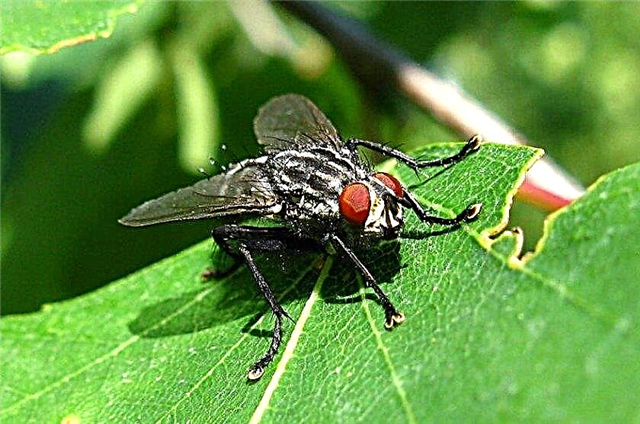
- Kila cabbage - more often appears on acidic soils, therefore it is necessary to carry out liming of the soil (200 g of lime per 1 m²). If the plants become infected, then they need to be removed, and the soil should be sprinkled with lime.

- Powdery mildew - its appearance is often preceded by excessive waterlogging and damp weather. In rainy summer, it is advisable to cover the plantings with a thin film, but at the same time it is necessary to ensure good ventilation. When a disease occurs, plants are sprayed with 1% Bordeaux fluid.

Harvest Dates
Lennox cabbage is harvested on average 150 days after emergence. This period falls at the end of September and the beginning of October.
In order for the crop to be stored for a long time, the following recommendations should be taken into account when harvesting a vegetable:
- Cleaning should be done in dry weather. The temperature should be between + 2 ... + 8 ° С.
- If autumn is rainy and dry, it’s difficult to wait, then heads of cabbage need to be dried in a dry room and only then lowered into the basement.
- Cabbage tolerates cooling to -3 ... -5 ° C, but do not stand it on beds until frosts. Upon reaching technical maturity, it should be removed from the garden.
- When picking heads, you need to save 2-3 integumentary green leaves, so the vegetable will be better stored.
- They store whole heads of cabbage without damage.
 Growing Lennox cabbage in your home garden will provide your entire family with quality and tasty products. To do this, you need to know the basic rules of agricultural technology for its cultivation and clearly follow them.
Growing Lennox cabbage in your home garden will provide your entire family with quality and tasty products. To do this, you need to know the basic rules of agricultural technology for its cultivation and clearly follow them.






